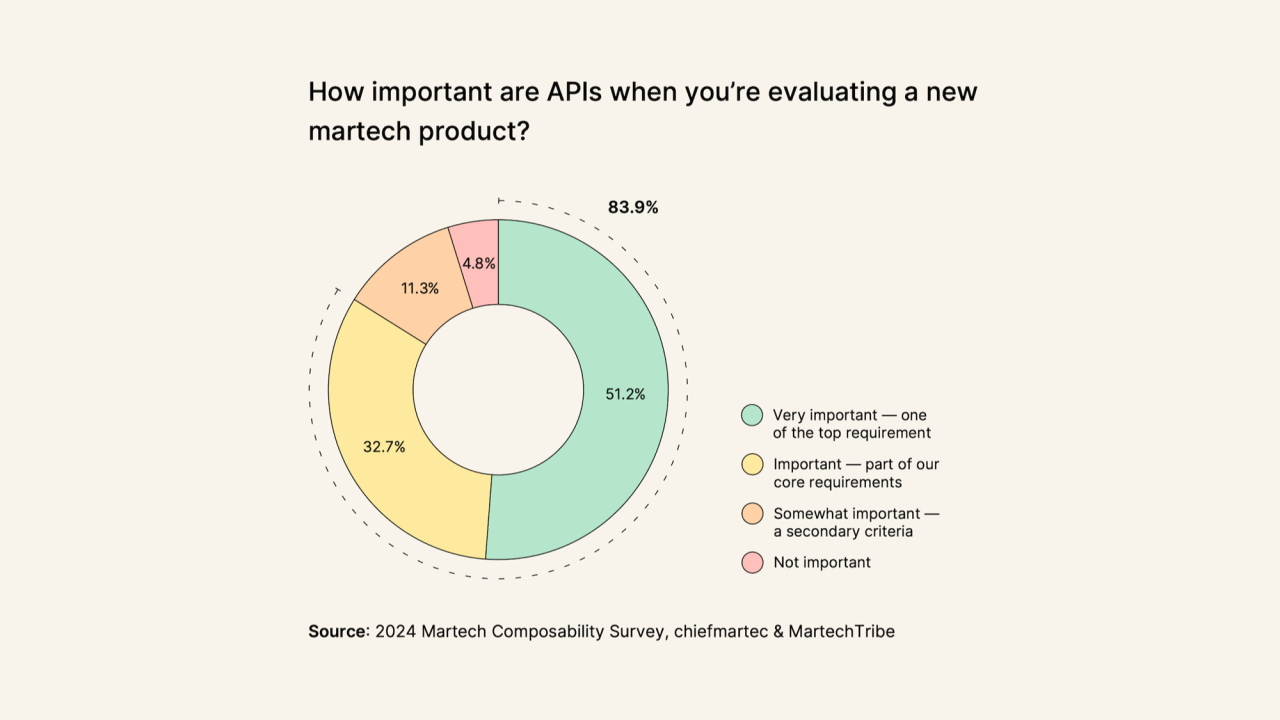
APIs: Critical Foundational Tech, Art Built on Science
In a recent survey by Chief MarTec, Scott Brinker published the findings that APIs are “very important” to martech buyers today (article).
On the technical side we’ve depended on APIs for years. Their importance is dawning on a wider audience that needs to understand them on a basic level.
We need APIs to connect systems since no one system does it all. Your organization may have separate systems to do things like keep track of purchase orders, track financial information, schedule manufacturing, manage warehouses, track programs and projects, manage creative production, manage creative content, etc. How to connect them in a useful way?
This is where APIs come into play. The acronym stands for “Application Programming Interface”. In practice, APIs provide a standardized way for applications to communicate with each other. Applications can include websites, desktop and mobile apps, databases, etc. Nearly every IT-based service you encounter probably uses APIs in some way. They work invisibly in the background.
It’s not just about bolting systems together. The connection provided by API is necessary but not sufficient. For instance, the data on a purchase order system has a different meaning from the data on a project management system. It’s as if one system speaks German and another speaks French. How to translate so the meaning of the data isn’t lost?
The first step is to understand what data is available on each system and what it means. It’s essential to engage the stakeholders of the systems that you need to connect. Again, what does the data mean? Once you understand the meaning you can figure out how to translate the data so the meaning is preserved. What is the desired flow of data and meaning? Is it a one-way feed or do the systems need to send data back and forth?
Then you’re ready to configure an intermediary system to connect to the systems and do the translation. It’s essential to have “sandbox” systems for testing. APIs usually have extensive access to your data. Isolated sandboxes protect your production data from corruption during development and testing. Once everything’s tested and working as expected the magic can begin.
ShotFlow is an “API first” software platform that represents the best practices of modern systems. Our Client API makes it easy to update or retrieve data from ShotFlow. To create a query to get the correct data, first create a filtered view that includes the required information. Then get the query string by inspecting the view using the browser’s developer tools. The query can then be used to formulate the API call. Similar queries are used to create or update information in the ShotFlow platform.
Most modern technology tools offer an API, but be careful about the reality versus the promise. APIs are hugely powerful tools, but they are just a tool, and like many tools, they require expertise to utilize properly.
Developing an API integration between two systems requires a deep understanding of both systems from a technical and business use perspective. It also represents a commitment to not only develop a codebase that can solve for the business needs while conforming to technical standards, rate limits, and best practices, but also to maintain that codebase over time as business scenarios and user needs change. This is a significant commitment for the organization in on-going resources, which can be very difficult to secure from already overloaded technical teams.
Shortcutting the integration process by doing something “quick and dirty” often results in overly simplistic “checkbox” integrations that don’t deliver the intended business value.
Many clients find there are simply too many business changes and related variables to commit to a “hard coded” API integration, at least during the initial phases of new system deployment.
ShotFlow developed our Data Ingest functionality to enable a “zero code” option for exchanging complex data and activity between ShotFlow and other Systems of Record. Data Ingest enables dynamic changes to data mapping across systems, plus incredibly powerful boolean logic-driven actions that can interpret data into actionable work with no human intervention. This requires no API development to leverage, and supports “point and click” changes on the fly as business rules and requirements change.
Clients who wish to connect systems must consider all the options available and look for systems that provide ultimate flexibility for today’s needs and the constant iteration that modern businesses require.
– Will Rutledge, Director of System Solutions
